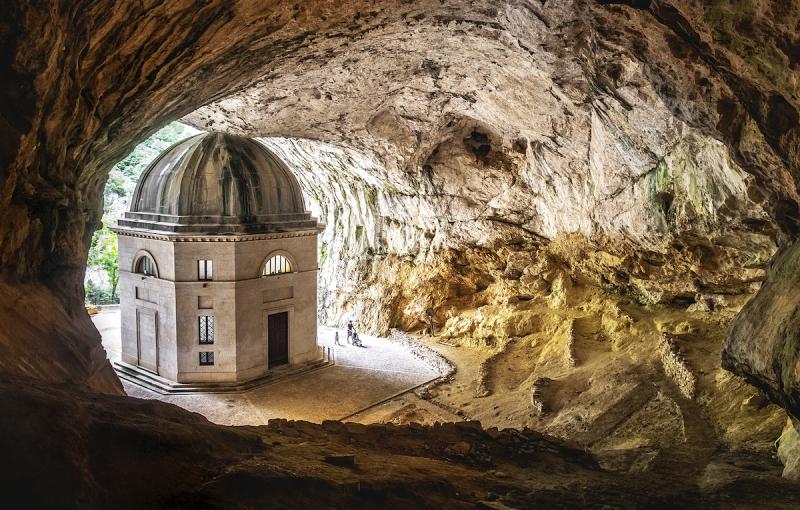Or, try Premium FREE for 30 days
Your support directly funds on-the-ground reporting from Italy (and the occasional aperitivo for our talented writers).
It’s all to bring you authentic Italy.
Join us.


Near the famed Frasassi Caves of Italy’s Marche region is a lesser known mountain cave which guards a neoclassical temple inside.
The octagonal-shaped the Temple of Valadier takes its name from the architect who designed it in the 19th century - Giuseppe Valadier, one of the most important Neoclassical architects in Italy. The small temple, which stands by the entrance to the cave, contains the copy of a statue of the Madonna and Child, which replaced the original, sculpted by Antonio Canova’s workshop, and now kept in the Genga Museum in the nearby town of Genga.
To appreciate the uniqueness of this architectural gem you have to see it in its actual context, enclosed as it is by the rocky walls of the cave.
It may seem like an odd and isolated place to build a temple, but this cave had been used since the 10th century, when the local population found refuge inside to escape raids and battles. In addition, a few meters from the Temple of Valadier is the ancient sanctuary of Santa Maria infra Saxa, whose presence is documented since 1029. Carved from the rock, it was originally a cloistered monastery of Benedictine nuns.
In 1828, Pope Leo XII, a native of nearby Genga, ordered the construction of the temple as a shelter for Christians who wished to ask for forgiveness. This earned the temple the nickname of ‘refuge of sinners.’
Genga is a town in the province of Ancona. This Marche town is best known as the ancestral home of the noble family of the Genga, whose most famous member was Pope Leo XII. Genga is also a spa center, with a nature reserve nearby as well as the famous Frasassi caves, among the largest and most spectacular in the world.
The temple is reached by walking slightly uphill for about one kilometer from the parking lot.
Vicino alle famose Grotte di Frasassi nelle Marche c'è una grotta di montagna meno conosciuta che custodisce un tempio neoclassico al suo interno.
Il Tempio di Valadier, di forma ottagonale, prende il nome dall'architetto che lo progettò nel XIX secolo - Giuseppe Valadier, uno dei più importanti architetti neoclassici d'Italia. Il tempietto, che sorge all'ingresso della grotta, contiene la copia di una statua della Madonna con Bambino, che ha sostituito l'originale, scolpita dalla b
Your support directly funds on-the-ground reporting from Italy (and the occasional aperitivo for our talented writers).
It’s all to bring you authentic Italy.
Join us.
Already a member? Sign in here.